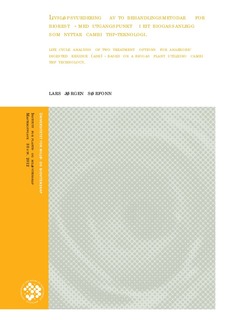| dc.description.abstract | The global focus on climate chance the recent years has led to a more environmental friendly
methods of treating organic waste. Earlier the organic waste was disposed on land fills, where it
decomposed under anaerobic conditions, releasing methane in the process. Biogas is produced
according to the same principle. In a biogas plant, organic matter undergoes anaerobic digestion in
airtight vessels. The methane is collected and can be used as an energy source for heat, electricity or
fuel.
In the last few years, an interest in biogas production has risen in Norway, in line with the focus on
climate change. A by‐product of biogas production is anaerobic digested residue (ADR), a nutrient‐
rich slurry suitable for fertilizer in agriculture. ADR may substitute for mineral fertilizer, which is
derived from an energy intensive production process. In Norway it is common to send the ADR to
treatment plants, thus the nutrients in the ADR will not be returned to the food production chain.
The biogas plant Mjøsanlegget in Lillehammer has been de‐watering their ADR since 2008, and the
liquid phase is being used as fertilizer for farmers in the Lillehammer area. The solid phase is
composted.
In Sweden non‐separated ADR has been used as fertilizer for many years, and it was therefore of
interest to see if this practice (scenario B) was environmentally advantageous compared to the
practice in Mjøsanlegget (scenario A). A life cycle assessment was performed for the categories
climate change, terrestrial acidification and freshwater euthropication in order to evaluate the
environmental performance of scenario A and B. Data collection for the analysis was performed by
contacting various actors in the biogasindustry, and through available literature. The simulation
software SimaPro was used to calculate the result.
One found that scenario A, which uses liquid phase asfertilizer and composts the solid phase had
15% lower climate change and acidification potential, and 65% lower potential for freshwater
eutrophication lakes compared to scenario B. Storage ofthe liquid phase and ADR in open vessels
contributed 61 % and 69 % to climate change potential respectively. N2O was the main contributor to
climate change potential for both storage and application. Transport of the liquid phase and ADR did
not contribute significantly (<15 %)to any of the environmental impact categories. NH3‐emissions
accounted for nearly all of the acidification potential, with the highest emission rates seen in the life
phase of application. Surface runoff of P for scenario A was only 35 % of scenario B, but more data is
needed to verify this last result. | no_NO |
